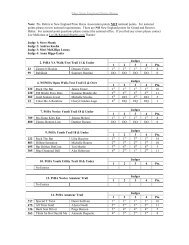2011 Official Rule Book - New England Pinto Horse Association
2011 Official Rule Book - New England Pinto Horse Association
2011 Official Rule Book - New England Pinto Horse Association
Create successful ePaper yourself
Turn your PDF publications into a flip-book with our unique Google optimized e-Paper software.
(4) Simulated Water. A plastic sheet, secured to<br />
the ground, so that it will not become affixed to<br />
the horse’s foot when a horse passes over the<br />
simulated water.<br />
d. Division D.<br />
(1) Carrying Object. Any object, other than animal or<br />
fowl, and of a reasonable size or weight, may be<br />
carried to a specific point.<br />
(2) Drag or Pull. Any object, other than animal or<br />
fowl, which can reasonably be pulled or dragged<br />
by the exhibitor. This obstacle should be in the<br />
course design such that the item to be dragged<br />
is on the handler’s left side. The excess lead may<br />
be carried in the handler’s right hand.<br />
(3) Mailbox. Remove and/or replace items. Side pass<br />
is optional. Note: Obstacles 1 and 3—if the object<br />
will be picked up/put down or opened/closed on<br />
the horse’s right side, the handler is allowed to<br />
hold the horse and the excess lead in his/her left<br />
hand while negotiating the obstacle.<br />
(4) Animal Hide. Lead next to an animal hide.<br />
(5) Serpentine. Obstacle consisting of four (4) pylons,<br />
guardrails optional, through which a horse will<br />
maneuver at a walk or jog-trot. Guardrails shall<br />
consist of poles placed parallel and a minimum of<br />
four (4) feet from the base of pylons; walk-pylons,<br />
minimum four (4) feet apart, base to base. Jogtrot<br />
pylons, minimum seven (7) feet apart, base to<br />
base.<br />
(6) Jog-around. Square consisting of four (4) poles,<br />
minimum twelve (12) feet long, and a pylon<br />
placed in the center of the square. Exhibitor will<br />
enter over a designated pole, perform a minimum<br />
90 degree jog around the pylon and exit over the<br />
designated pole. The handler should be in the<br />
box with the horse.<br />
(7) Jog-through. Shall consist of poles L, double L,<br />
V, U or similar shaped obstacle. Poles should be<br />
on the three (3) feet minimum and four (4) feet<br />
maximum. Handler may be inside or outside the<br />
jog-through.<br />
E. Judging, Yearling <strong>Horse</strong> Trail In-Hand<br />
1. Judges should consider the overall appearance of the<br />
horse, conditioning and grooming, and the equipment<br />
(dirty, ill-fitting or ragged equipment) in his/her overall<br />
scores. Also to be considered is the correctness of the<br />
horse while being led. Drifting to the side, leading or<br />
stopping crooked, failure to maintain a pivot foot in a turn,<br />
leading or turning sluggishly should be considered and<br />
evaluated in the horse’s maneuver scores and reflected<br />
in its overall score. Handlers should be discouraged from<br />
excessive verbal cues and excessive stiff or unnatural<br />
movements around horse or when leading. For safety<br />
reasons, those handlers continuously holding the chain<br />
on the lead, tightly coiling lead shank around hand, or<br />
dragging the lead shank should be penalized.<br />
2. All faults are to be assessed against the horse and not the<br />
exhibitor.<br />
F. Scoring System, Yearling <strong>Horse</strong> Trail In-Hand.<br />
1. Scoring will be on the basis of 0-infinity, with 70 denoting<br />
an average performance. Each obstacle will receive an<br />
obstacle score that should be added or subtracted from 70<br />
and is subject to a penalty that should be subtracted.<br />
<strong>2011</strong> PtHA <strong>Rule</strong> <strong>Book</strong> 127<br />
ClassEs



